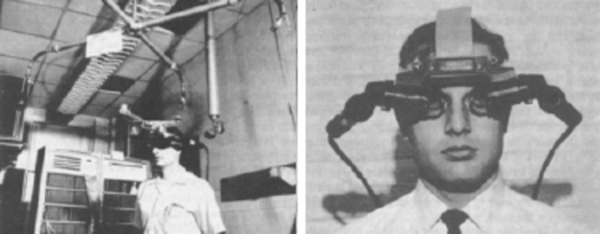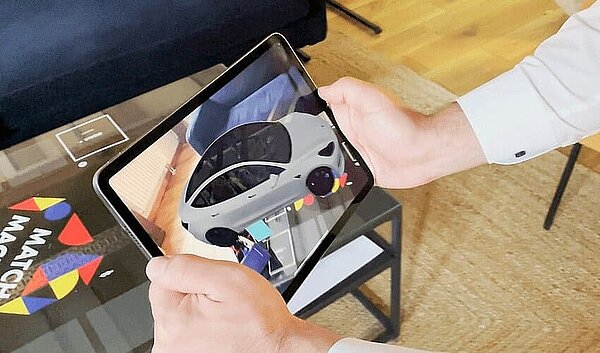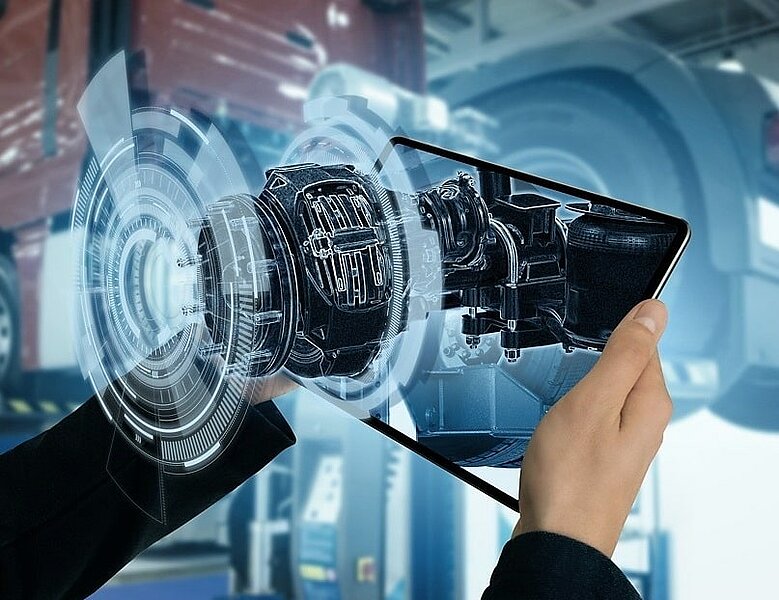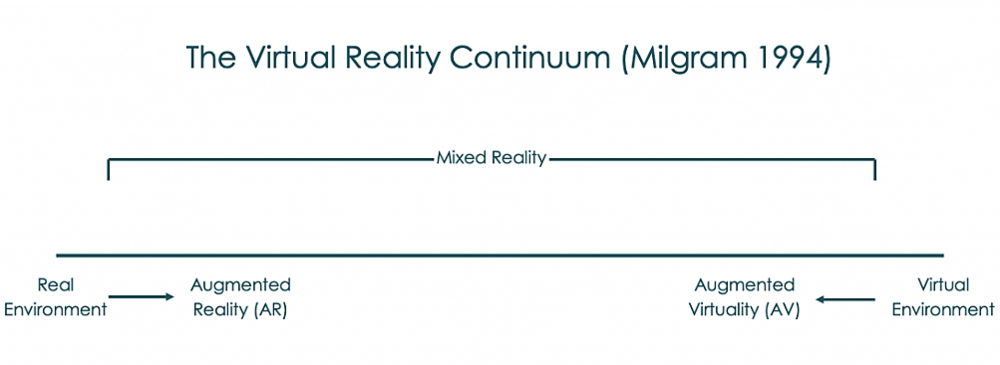Virtual, Augmented or Mixed Reality?
VR, AR, MR?
The terms virtual reality, augmented reality, augmented virtuality and mixed reality are currently enjoying a high level of popularity. Have you ever wondered where exactly the differences are and how these technologies with great growth potential differ from each other?
In the following, we highlight the theoretical approach in the form of basic explanations and provide an insight into practice, including some application examples.

Where did it actually begin?
Virtual Reality was born back in 1965, when Ivan Sutherland announced the project "The Ultimate Display". In 1968, the first head-mounted display was presented, i.e. a screen that can be worn on the head (today colloquially known as VR glasses). Over time, various forms have evolved from this. Today, this information can already be displayed using smartphones or smaller data glasses.
Image source: Research Gate
What is Virtual Reality (VR)?
The term virtual reality describes the perception of a virtually created world. Virtual reality is a computer-generated 3D environment in which the user is completely located and with which he interacts individually in real time or experiences it immersively by means of his own decisions and interactions.
Virtual reality is already being used by the industry today, for example in the sale of luxury cars. Audi uses the virtual experience to customize features such as tires, color and interior of the car as desired by the customer. This creates a completely new (brand) experience. You surprise, excite and emotionalize the potential customer combined with the practical benefits.
VR can also be used to convey teaching content in a more practical way in training and continuing education. For example, a large number of companies such as BMW, Jungheinrich and Deutsche Bahn are already using VR glasses in training. BASF sees VR as an opportunity to increase productivity and safety in chemical production.
What is 360°?
360° is considered a subcategory of virtual reality. In a 360° world, the user is immersed in the real world, which is nevertheless virtual because the user is not in the same place. Thus, it is possible to transport the user to another continent through a 360° photo or video without the user being there. This technology makes it possible, for example, to get to know Cologne Cathedral, the Saxon Parliament or parts of New York with a 360° tour from any point on earth.
With 360°, a distinction is made between two forms: Photos and videos. Creating a 360° photo is already possible with a smartphone by capturing a kind of panoramic image through a rotating motion.
To record a 360° video, however, you need special equipment in the form of a 360° camera. With such a camera, a particularly high resolution is important, since the pixels are distributed over the entire sphere of the camera and not just over a section of the image. For this reason, you should record at least with a 4K resolution.
Producing a 360° video is now easier than it was a few years ago. Most cameras can be controlled via app and the data can be transferred wirelessly to the PC. There are also many platform providers such as Matterport.
What is Augmented Reality (AR)?
Augmented reality translates as "extended reality" and is closer to reality than virtual reality. Virtual motifs are incorporated into a real world, causing the user to perceive an augmented reality.
Just like virtual reality, it is a computer-generated phenomenon. However, in this case, the physical real world is merely supplemented with virtual building blocks. Humans need devices, e.g. smartphones or glasses (HMD) like the Microsoft HoloLens. In AR, these input devices receive the data in real time, process it and display it to the user. To do this, the virtual objects are anchored in reality at a position so that they appear to be part of the real world, regardless of the user's point of view (or the camera).
The application possibilities are diverse in both the B2C and B2B environments. One of the best-known examples of AR is certainly the game Pokemon Go. Players can catch virtually placed creatures in the real world via GPS and compete with other players. In addition to gaming, there are many other areas of application:
- Digital fitting of jewelry, make-up or sunglasses by means of facial recognition: Misterspex, among others, offers such a service.
- Additional information in exhibitions (via a display and/or audio tracks) in museums as soon as the visitor stands in front of the exhibit. This is already possible at the American Museum of Natural History.
- Virtual tour guides for city tours, as in Munich, Monheim or Wiedenbrück, among others.
- Remote support to assist people from a distance
- Animated filters on social media platforms for interactive interaction, as with the app SnapChat
- Head-up displays in cars, such as Mercedes' new S-Class (see video)
- Virtual penalty or offside lines in sports broadcasts, as with FIFA or the DFL
- Animated instructions on real product for training etc. (HoloAnatomy)
- Guided maintenance for service technicians
What is Augmented Virtuality (AV)?
Augmented virtuality mainly takes place in a virtual world, but the real world is also integrated.
This refers to applications in which the user wears a VR headset to play, but still perceives information from the real world, for example other people in the room, via a microphone. Real objects can also be integrated into the virtual world, for example to warn the user if he or she gets too close to a wall.
And what is mixed reality or XR?
Everything between the two ends of realities, the physical, real world on the one hand and the virtual world on the other, is called mixed reality. What we predominantly use today is augmented reality, so that these terms are (can be) used synonymously today.
From theory to practice
Augmented reality describes the integration of digital information into the real world. This can be entire objects or information. The many examples, whether in AR or VR, can be divided into various use case classes, such as
- Training & Education
- Guided Worflows
- Remote Support
- Product Configuration
- Product Visualization
- Special solutions

The next step
If we have aroused your curiosity and you would like to try out the technologies live, the Spacific Experience Workshop is a particularly good place to start. If you have any questions or would like a personalized quote, please do not hesitate to contact us.



